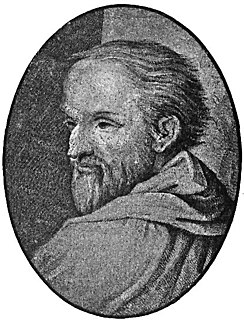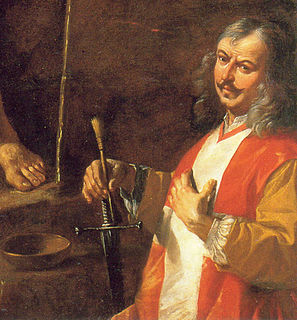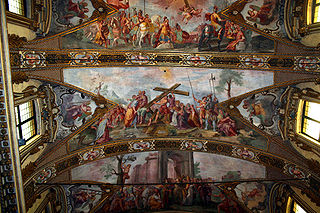Related Research Articles

Antonio Allegri da Correggio, usually known as just Correggio, was the foremost painter of the Parma school of the High Italian Renaissance, who was responsible for some of the most vigorous and sensuous works of the sixteenth century. In his use of dynamic composition, illusionistic perspective and dramatic foreshortening, Correggio prefigured the Baroque art of the seventeenth century and the Rococo art of the eighteenth century. He is considered a master of chiaroscuro.

Federico Barocci (c. 1535 in Urbino – 1612 in Urbino) was an Italian Renaissance painter and printmaker. His original name was Federico Fiori, and he was nicknamed Il Baroccio. His work was highly esteemed and influential, and foreshadows the Baroque of Rubens. He is generally considered the greatest and the most individual painter of his time in central Italy.

Domenico Zampieri, known by the diminutive Domenichino after his shortness, was an Italian Baroque painter of the Bolognese School of painters.

Giovanni Battista Castello was an Italian historical painter.
Bernardo Castello (1557–1629) was an Italian painter of the late-Mannerist style, active mainly in Genoa and Liguria. He is mainly known as a portrait and historical painter.

Mattia Preti was an Italian Baroque artist who worked in Italy and Malta. He was appointed a Member of the Order of Saint John.

Camillo Procaccini was an Italian painter. He has been posthumously referred to as the Vasari of Lombardy, for his prolific Mannerist fresco decoration.

Giovanni Battista Paggi was an Italian painter, sculptor, and writer. His style spans the Late-Renaissance and early-Baroque.

Alessandro Maganza (1556–1630) was an Italian painter of the Mannerist style, born and active in Vicenza, as well as in Venice.

Francesco Curradi or Currado was an Italian painter of the style described as Counter-Maniera or Counter-Mannerism, born and active in Florence.

Giovanni Battista Carlone (1603–1684) was an Italian painter of the Baroque period, active mainly in Genoa.

Domenico Fiasella was an Italian painter of the Baroque period, mainly active in Genoa. He was nicknamed Il Sarzana, after his birthplace.

Santi Prunati was an Italian painter of the Baroque era, born and mainly active in Verona.

San Francesco della Vigna is a Roman Catholic church in the Sestiere of Castello in Venice, northern Italy.

Astolfo Petrazzi (1583–1665) was an Italian painter of the Baroque period, active mainly in his hometown of Siena, but also Spoleto and Rome. He was a pupil of mainly Francesco Vanni, but also worked under Ventura Salimbeni and Pietro Sorri. He died in Siena.

Benedetto Brandimarte or Brandimarti was an Italian painter. He is a representative of the Mannerist style, which is reflected in the extreme artificiality shown in the unnatural movement of the figures and the brilliance of the colors of his works.

Cristoforo Caselli, also known as Da Palma or il Temporello or Cristofaro Castelli, was an Italian painter of the Renaissance period.

Antonio Brilla was a prolific Italian sculptor and ceramic artist mainly active in Liguria. He travelled in 1838 to Florence to study masterworks, where he met Giovanni Duprè and Lorenzo Bartolini. He returned to Savona to establish a studio. Two of Antonio's sons also were artists.
Francesco Nasini was an Italian painter of the Baroque period, active mainly in towns outside of Siena, Italy.
References
- ↑ "Archived copy" (PDF). Archived from the original (PDF) on 2008-04-05. Retrieved 2008-05-12.
{{cite web}}: CS1 maint: archived copy as title (link) - ↑ Memorie biografiche poste in forma di dizionario dei pittori, scultori, architetti, ed incisori Mantovani, by Pasquale Coddè, page 11.
- Bryan, Michael (1886). Robert Edmund Graves (ed.). Dictionary of Painters and Engravers, Biographical and Critical. Vol. I: A-K. London: George Bell and Sons. p. 80.